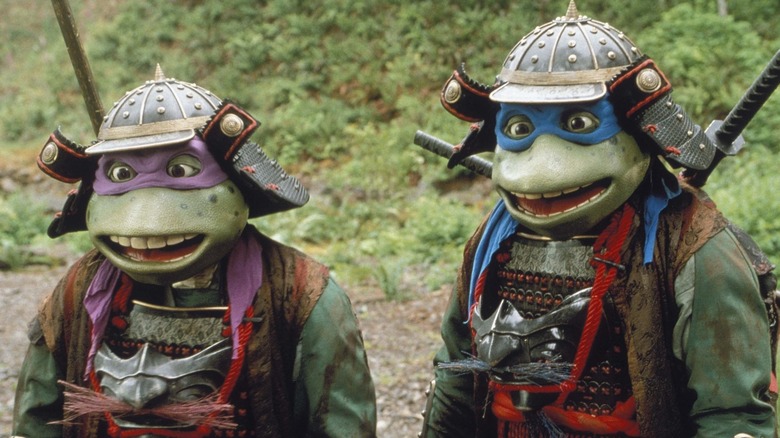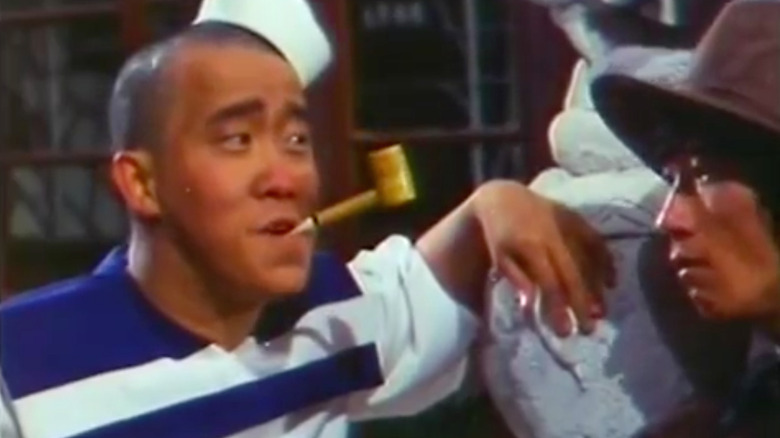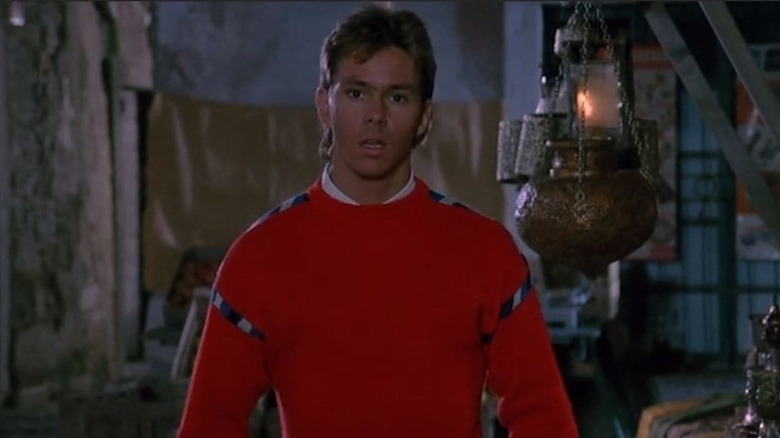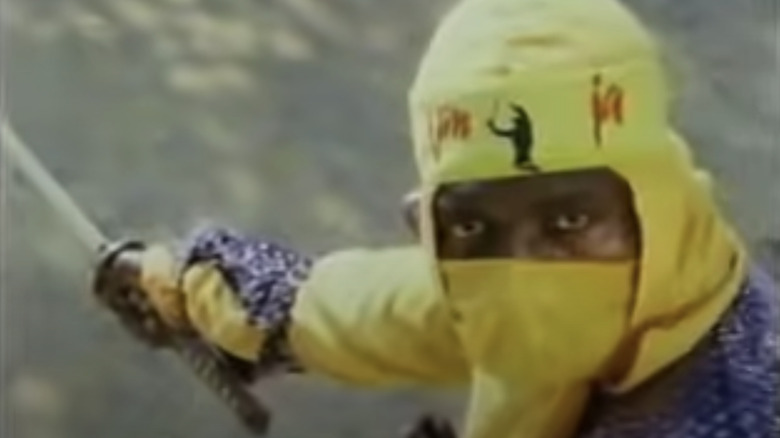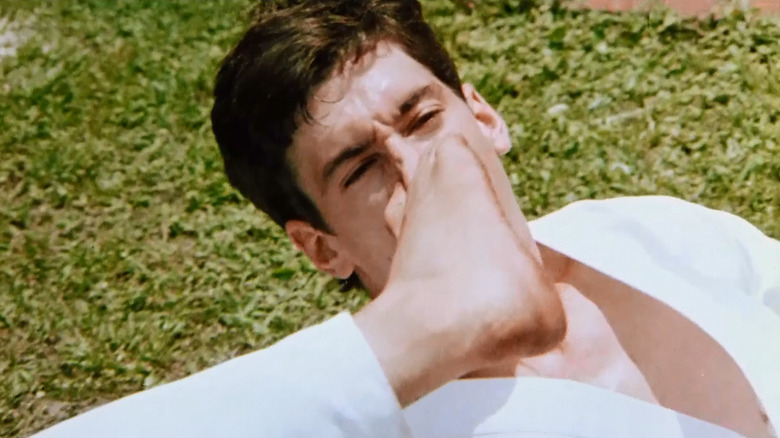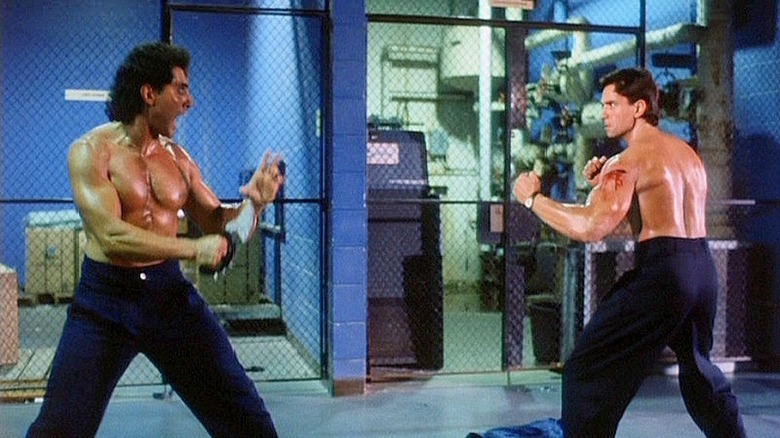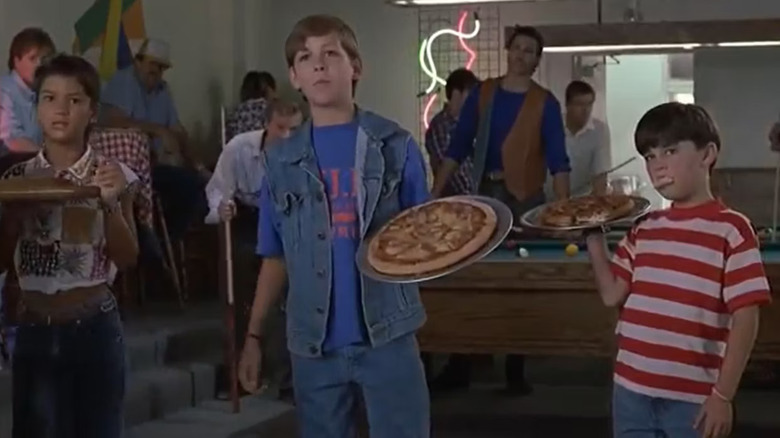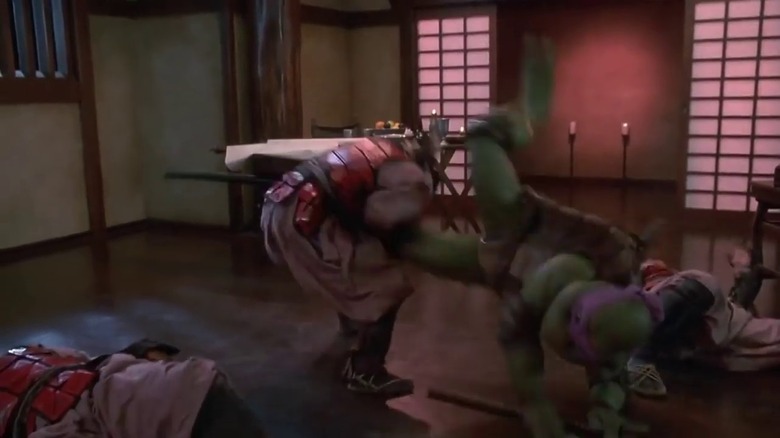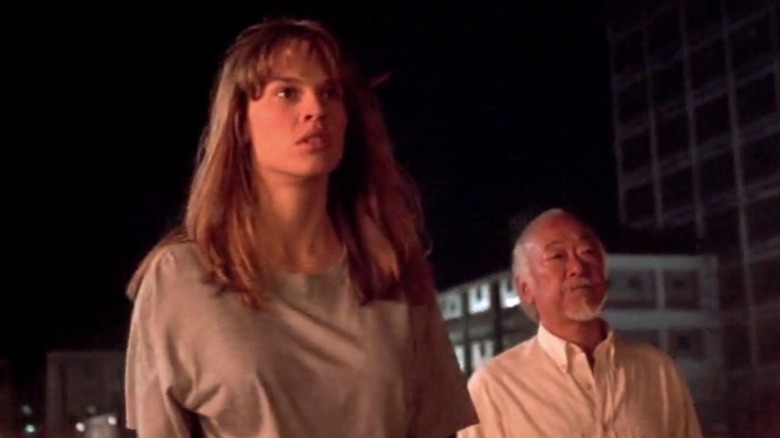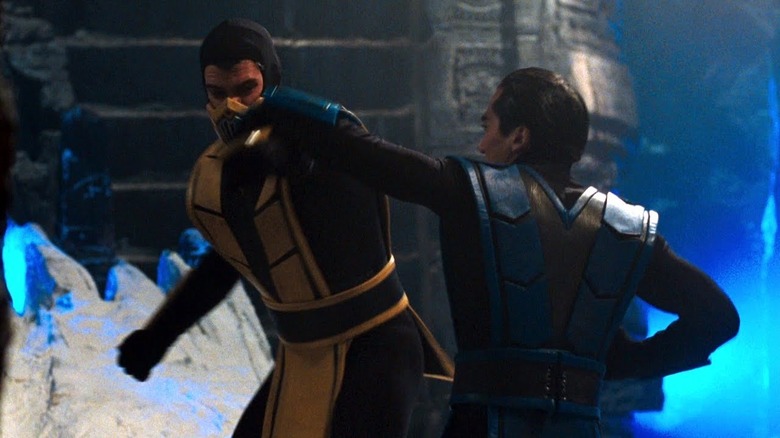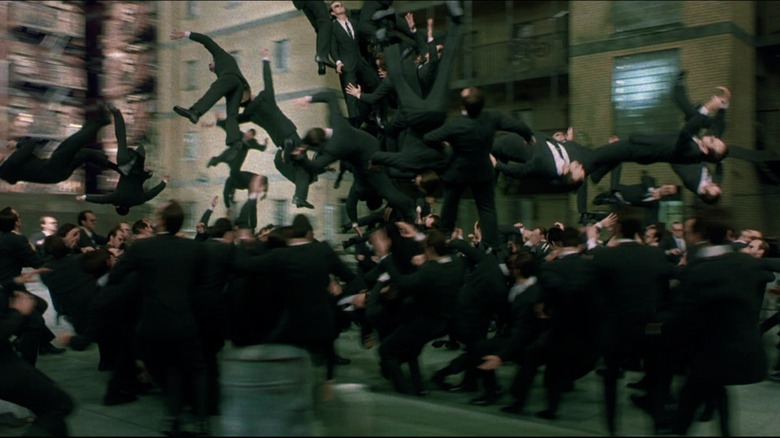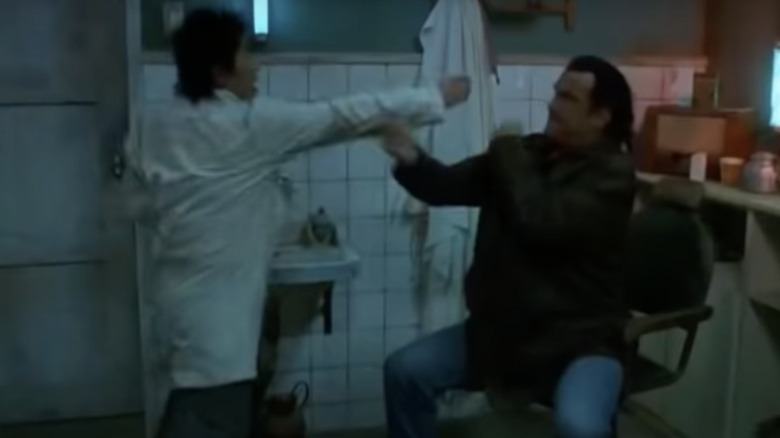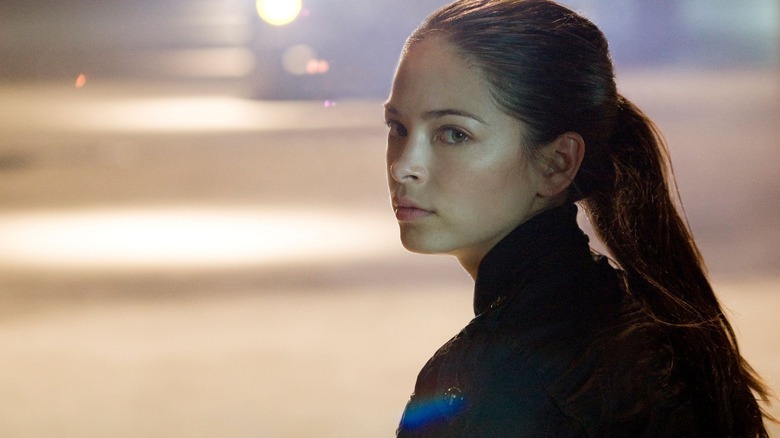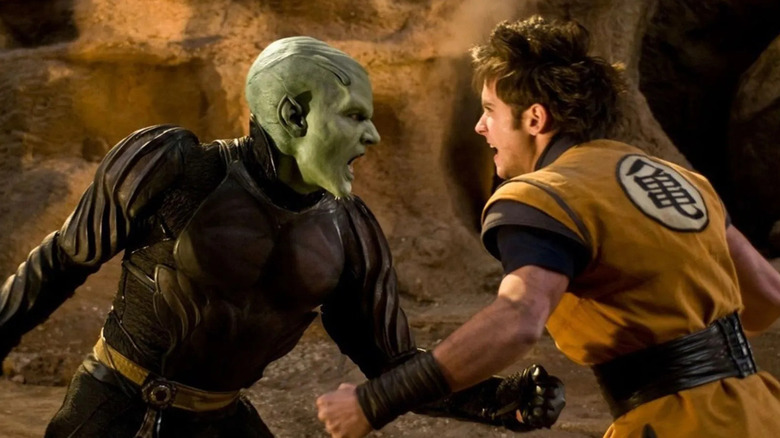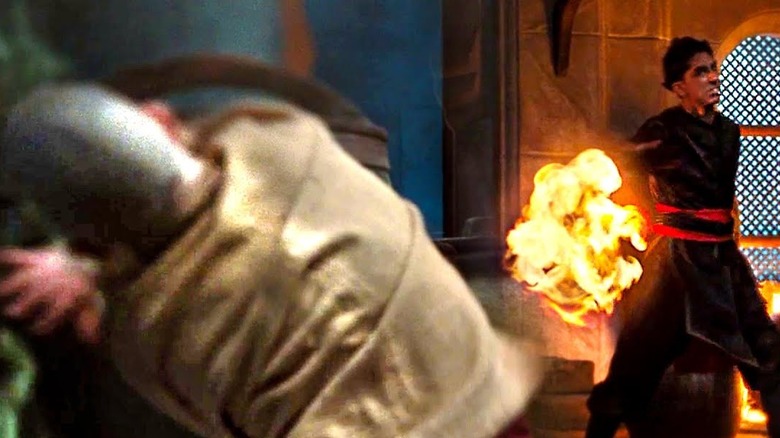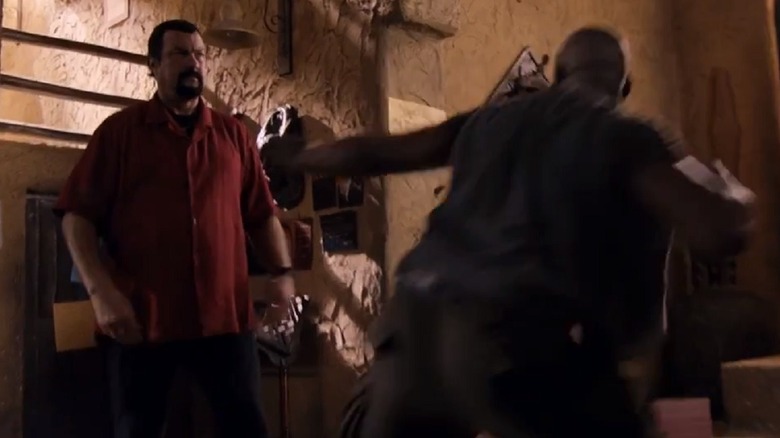The Worst Choreographed Martial Arts Sequences In Movie History
Martial arts have been part of culture for ages now. The combat traditions have especially found a place in pop culture due to the popularity of martial arts films, one of the biggest and highest-selling genres in the entire world, spawning movie stars like Bruce Lee, Jackie Chan, and Michelle Yeoh.
Even in today's film industry, martial arts combat is very present in blockbusters, from the MCU's "Shang-Chi and the Legend of the Ten Rings" to Oscar winner "Everything Everywhere All At Once." However, perfecting — and more importantly, displaying — the fighting style requires a lot of dedication and craftsmanship. As a result, there have been many sequences depicting martial arts that underwhelmed fans of the genre.
These 15 films vary from foreign B-movies to blockbuster IP, yet in each of them, the depiction of martial arts is sadly not up to scratch. Whether it's due to clumsy directing, unbelievable actors, or in many cases, poorly-rendered CGI effects, these fight scenes tried and failed to showcase this iconic form of action, and the results are plain to see.
The Dragon Lives Again
Bruce Lee was a legendary figure not only in martial arts, but Hollywood in general. His career included iconic martial arts films like "Fist of Fury" and "Enter the Dragon" in the early 1970s. Sadly, Lee passed away in 1973, but remained an influential figure in the film genre, inspiring filmmakers only a few short years after his death — although some of their homages left something to be desired.
The 1977 film "The Dragon Lives Again," directed by Law Kei, pays tribute to Lee's legacy by centering the film on a fictionalized version of the deceased actor, played by Bruce Leung Siu-Lung. In the film, Lee wakes up after his death in the Underworld, where he meets and comes to blows with characters from throughout pop culture including James Bond and The Godfather, and is eventually hunted by none other than Count Dracula.
One of the more unbelievable fight scenes in the film finds Popeye, played here by Eric Tsang, fighting against mummies after devouring a can of spinach. The choreography tries to replicate Popeye's style of fighting, although many of the mummies he's up against barely move. On top of that, it rarely ever looks like Popeye's punches are actually making contact with the mummies he's facing.
Gymkata
Martial arts films tend to be underwhelming when they cast non-actors in their lead roles. That was the first mistake of the 1985 film "Gymkata," directed by Robert Clouse and starring Olympic gymnast Kurt Thomas as Jonathan Cabot, a man selected by the American government to enter an athletic competition against other countries where the prize is a wish for the winner.
"Gymkata" has since gathered a cult following, listed by Maxim as one of the worst movies ever made in 2002. One can imagine that in a film whose title clumsily combines the words "gymnastics" and "karate," the fight scene choreography would be as poorly thought-out. In one scene, Thomas's character is ambushed by terrorists at a marketplace, fighting them off with ludicrous jump-kicks and unnecessary flips.
The goons are more than willing to let Thomas's character set up his attack with a big acrobatic flourish, and when they're hit once, they stay down. While it's a pretty poor fight scene choreography, it makes for an entertaining watch. So perhaps "Gymkata" has earned its legacy as a cult classic, after all.
Ninja: Silent Assassin
"Ninja: Silent Assassin" has gone by many other titles, including its UK title "Knight & Warrior," as well as its French title, "Black Ninja." The film was directed by Godfrey Ho, who directed over a hundred movies in Hong Kong that are often regarded as the best of the worst, including "Undefeatable" and "Robo Vampire."
Released in 1987, "Ninja: Silent Assassin" centers on a police officer who seeks revenge against a Hong Kong drug kingpin for killing his wife. At the same time, a young Black man is on a hunt for the exact same kingpin. The film's climactic fight scene, for some reason, starts with a poorly-acted phone conversation. By the time it actually begins, the fight scenes aren't directed any better than the dialogue.
The "Ninja: Silent Assassin" final fight commits the worst crime of any martial arts sequence: It's boring. Most of it consists of long, drawn-out shots of the ninjas staring at each other and readying their weapons, but once they actually start swinging, the editing gets choppy and doesn't shy away from including even more extreme close-ups rather than capturing the choreography.
Miami Connection
"Miami Connection" was released in 1987 and was written, directed, and produced by Y.K. Kim, who also stars as Mark, a member of "Dragon Sound," a band composed of Taekwondo-practicing orphans. In the film, a motorcycle gang of ninjas kidnaps the lead singer, forcing the rest of the band to rescue him.
Kim produced the film entirely independently, casting his Taekwondo students and hoping the finished product would interest a distributor, although as Kim later recounted to CNN, "I showed ['Miami Connection'] to hundreds of different studios and distribution companies ... They all said, 'This is trash. Don't waste your time.'" Despite the clear passion put into the project, Kim probably should've listened to their criticism at the time.
In one scene, the gang members are confronted in a railhead by the band, who take them on all by themselves. Most of the thugs, however, spend the fight watching their friends get taken out one by one by the bandmates. The one saving grace of this scene is the epic '80s synth music playing over it.
Undefeatable
The 1993 film "Undefeatable" is another low-budget project of Godfrey Ho. Cynthia Rothrock, herself a martial arts world champion, stars as Kristi, a street fighter who begins investigating a serial killer named Stingray, who begins lashing out after his abused wife abandons him. The hunt leads to a warehouse, where Kristi and a detective, Nick, confront Stingray and brutally kill him.
Though the fight sequence at the film's climax is satisfyingly gruesome, most of it involves slow-motion punches that aren't really slow-motion, just the actors pretending to move in slow-motion. Nick and Stingray also lose their shirts for no apparent reason other than to show off, and both make the most of every labored groan.
Despite its poor quality, the final fight garnered the film attention, eventually being featured on an episode of "World's Dumbest...," a show highlighting terrible fight scenes. "Undefeatable" was elevated from a forgettable Godfrey Ho B-movie to a viral cult classic. It may not be the best martial arts film, but it's certainly one of the most memorable.
3 Ninjas Knuckle Up
"3 Ninjas," originally released in 1992, centers on three brothers who learn martial arts and subsequently use their skills to aid their father in an FBI hunt for a criminal mastermind. It eventually sparked a film series helmed by other directors, starting with "3 Ninjas Kick Back" in 1994, and then "3 Ninjas Knuckle Up" in 1995.
In one of the film's early scenes, the brothers are confronted at a pizza parlor by punks. One would imagine it'd be impossible for a group of adult men to be successfully beaten by a trio of pre-teen ninjas, especially when said pre-teen ninjas are all holding a small-sized pizza in one hand. Nevertheless, the martial arts sequence that proceeds is exactly that, as the adults do a pathetic job of evading clearly telegraphed kicks and dodges from each of the kids.
Furthermore, the fight scene is quite long, stretching to almost four minutes from the first to the last punch. Although the kids showcase impressive moves, the entire premise of it is pretty ridiculous, and the choreography behind the adults in the scene is lackluster.
Teenage Mutant Ninja Turtles III
The Teenage Mutant Ninja Turtles were an iconic staple of 1980s pop culture, originating in comic books and eventually debuting as a Saturday morning cartoon in 1987, setting the standard for what martial arts action these four pizza-loving turtles would get into every week.
When adapted to live-action films, however, the fight scene choreography had to get more creative, considering the turtles were being played by human stunt performers in suits. While the first film, released in 1990, was a box office success, the third film, which was released in 1993, underwhelmed fans and critics.
As seen in one fight sequence, the quartet of turtles time-travel to feudal Japan, where they are attacked by a group of samurai. The fight then proceeds awkwardly, with the four turtles separated as they each deal with their equal share of adversaries. Sound effects and cutesy catchphrases aside, this fight is missing any sort of stakes or interesting choreography that the TMNT are typically known for.
The Next Karate Kid
"The Karate Kid" is one of the most well-known martial arts media franchises in the entire world, starting in 1984 with the film starring Pat Morita and Ralph Macchio. The combat style of karate became incredibly popular in Western countries due to its depiction in "The Karate Kid," making it one of the most influential martial arts films.
That legacy weighed heavy on "The Next Karate Kid," which was released in 1994. This time around, Ralph Macchio was replaced by Hilary Swank in her breakout role as Julie, becoming Mr. Miyagi's new martial arts pupil. Despite praise for the film's terrific lead performances, its action sequences pale in comparison to the first three films, as seen in its climactic showdown.
After Julie's love interest Eric is ambushed by fraternity brothers, Julie challenges their leader, Ned, to a fight. For a fight scored to epic orchestral music, Julie takes Ned down without much trouble at all. His only retaliation is throwing mud in Julie's face to blind her, which lets him, again, easily throw her to the ground. Overall, this fight lacks the clever choreography or stakes that made "The Karate Kid" a pop culture phenomenon.
Mortal Kombat Annihilation
"Mortal Kombat" was one of the most influential video games of the 1990s, spawning a multimillion-dollar media franchise. The success of "Mortal Kombat" quickly sparked interest in adapting it into a Hollywood movie, which came in 1995.
The first "Mortal Kombat" movie was followed up two years later with a sequel, "Mortal Kombat Annihilation." While the first film wasn't a critical darling, it was praised for its action sequences, which is not something the second film could boast. "Mortal Kombat Annihilation" was a failure critically and commercially, with Entertainment Weekly describing his cinematography as being "shot according to the whiplash school of hyperactive mayhem."
The film doesn't even do justice to the franchise's most iconic characters, Scorpion and Sub-Zero. Complete with lackluster VFX and stiff actors, this scene is the ultimate showcase of why translating video games to movies was looked down upon for so many years after its release. Another "Mortal Kombat" film didn't come until 2021, which replenished the credibility of the franchise's martial arts choreography.
The Matrix Reloaded
"The Matrix" was released in 1999 and redefined action film choreography for decades to come, combining the Wachowskis' love for martial arts films with science fiction and anime. This success resulted in two sequels shortly after: "The Matrix Reloaded" and "The Matrix Revolutions."
"The Matrix Reloaded" was liked by many but considered to be a major step down from the first film. One of its most iconic scenes, known as the "Burly Brawl," finds Neo ambushed on a rooftop by endless hordes of Agent Smith clones, which is an opportunity for the directors to showcase their leveled-up martial arts choreography. Unfortunately, the scene's VFX put a damper on the potential for a well-choreographed fight sequence.
In fact, most of the scene plays out like a video game cutscene from the early 2000s. Agent Smith clones are tossed around, with Neo's plot armor really being shown off as he's swarmed by assailants who barely lay a finger on him. Aside from a few well-framed shots, the bulk of the scene is a barrage of CGI and fast-paced action that lacks the first film's extravagant detail.
Out for a Kill
When it comes to terrible martial arts films, there is no one more notable than Steven Seagal. Throughout the 1990s, the action star gained a reputation for his arrogant behavior off-screen, including a now-infamous hosting gig of "Saturday Night Live" in 1991 where Seagal refused to appear alongside popular characters Hans and Franz.
Since the early 2000s, Seagal's appearances have been limited to direct-to-video releases, such as "Out for a Kill," which was released in 2003. In the film, Seagal plays a professor at Yale University who gets unknowingly involved in a Chinese drug smuggling operation, which eventually leads to a confrontation with a figure known as "The Barber."
The fight between Seagal and The Barber is laughably terrible — to put it nicely. It has all the makings of a classic Seagal fight scene: Sped-up fighting, little movement from Seagal, obvious wirework, and unnecessary slow motion. At one point, The Barber is practically flying like Peter Pan as Seagal tries to fight him from below, before being killed with a curtain.
Street Fighter: The Legend of Chun-Li
Much like "Mortal Kombat," "Street Fighter" is one of the most iconic game franchises of all time, with Chun-Li being a series staple since 1991. There was a lot of pressure to get the action right when Capcom co-produced "Street Fighter: The Legend of Chun-Li" in 2009, starring Kristin Kreuk as the titular martial artist.
In typical fashion for video game movies, "Street Fighter: The Legend of Chun-Li" was a critical disappointment. While Kreuk's Chun-Li never dons her iconic costume, another iconic "Street Fighter" character appears on screen: Vega. Chun-Li and Vega face off during the film, which ideally should be where it pays the most tribute to the "Street Fighter" franchise.
Long story short ... it doesn't. The scene is set at night, making the characters hard to see and their movements even harder to track. What it does get right about "Street Fighter" matches is that the two characters also spend most of the match not hitting each other, only to land one blow and really soak in the moment.
Dragonball Evolution
Calling "Dragonball Evolution" a martial arts film will likely insult fans of the genre. Greenlit during the 2007 writers' strike, fans were skeptical of Hollywood's ability to capture the action sequences from the manga and anime franchise. As it turns out, they were right to be worried.
The film at least harks back to the origins of "Dragonball" during its climax, where Justin Chatwin's Goku appears in his iconic outfit to face King Piccolo. Terrible special effects aside, this martial arts sequence doesn't have half the excitement of any fight scene in "Dragon Ball Z." They spend most of the fight trying and failing to hit each other with energy blasts.
It doesn't help when they finally do make contact, and immediately fly into the sky via unimpressive wire work, awkwardly clinging to each other as they trade punches. For most of the rest of the scene, the two of them rarely occupy the same shot.
The Last Airbender
M. Night Shyamalan has directed some stellar films, including "The Sixth Sense," and "Split." However, his creative slump in the late 2000s included his greatest failure: The 2010 live-action adaptation of "Avatar: The Last Airbender," widely considered one of the greatest animated series of all time.
The film, "The Last Airbender," has since become regarded as one of the worst films ever made. Many scenes showcase its lack of regard for the animated series' action choreography, but none more so than one confrontation between Aang and Zuko, which begins with an unbelievable moment where Zuko fails to notice Aang standing right behind him.
The fight scene that follows features plenty more awkward moments between the two, including when Zuko picks Aang up like a baby, giving Aang the opportunity to wrap his legs around Zuko and flip him to the ground. Aside from that, it's mostly attacks that seem so obviously telegraphed you could see them coming from a mile away.
China Salesman
Our old friend Steven Seagal hasn't let time stop him from continuing to make terrible martial arts movies. Nowadays, he's relegated to supporting roles in films like 2017's "China Salesman," written and directed by Tan Bing. This film features a ridiculous fight scene between Steven Seagal and one other recognizable celebrity.
That celebrity is none other than heavyweight boxing champion Mike Tyson. Tyson shares the screen with Seagal in a sequence that unsurprisingly features not a single moment of good acting from anybody involved. After a fight breaks out in a tavern, Seagal and Tyson come face to face in what should be the showdown of the century.
Simply put, showdown of the century it is not. The entire building clears for these two to face off, but it ends up feeling like slow-motion even when it's not. Tyson spends a significant amount of time breaking columns with his fists, while Seagal, in a dramatic slow-mo, slaps Tyson in the ear.
